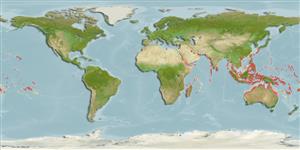Common names from other countries
Environment: milieu / climate zone / depth range / distribution range
экология
морской; солоноватоводный ассоциированный с рифами; пределы глубины 0 - 5 m (Ref. 9710), usually 0 - 1 m (Ref. 9710). Tropical; 32°N - 32°S
Indo-Pacific: Red Sea and East Africa to the Line, Marquesan, and Tuamoto islands, north to southern Japan, south to Lord Howe and Rapa.
Size / Вес / Возраст
Maturity: Lm ? range ? - ? cm
Max length : 16.0 cm TL самец/пол неопределен; (Ref. 48636); 13.2 cm SL (female)
Краткое описание
определительные ключи | морфология | морфометрия
колючие лучи спинного плавника (общее число) : 12 - 13; членистые (мягкие) лучи спинного плавника (общее число) : 19 - 21; колючие лучи анального плавника: 2; членистые (мягкие) лучи анального плавника: 21 - 23. Males darkly dusky with 5-6 pairs of bands on body and pale stripes on dorsal fin; develop a crest. Females paler in color, bands broken into spots posteriorly, dorsal fin spotted (Ref. 4404).
Facultative air-breathing (Ref. 126274); Intertidal (Ref. 31184, 48636). Adults are common in areas with large rubble pieces which are often used to built breakwaters or to support jetty-pylons (Ref. 48636). They hide in cracks or holes when not feeding. They jump out of the water in energetic skippings to another pool when pursued (Ref. 2158, 48636). May remain out of water under rocks or seaweeds (Ref. 31184). They breathe air when out of water (Ref. 31184). Feeds on filamentous algae (Ref. 89972). Oviparous. Eggs are demersal and adhesive (Ref. 205), and are attached to the substrate via a filamentous, adhesive pad or pedestal (Ref. 94114). Larvae are planktonic, often found in shallow, coastal waters (Ref. 94114).
Life cycle and mating behavior
Maturities | размножение | Spawnings | Egg(s) | Fecundities | личинки
Distinct pairing (Ref. 205).
Springer, V.G. and J.T. Williams, 1994. The Indo-West Pacific blenniid fish genus Istiblennius reappraised: a revision of Istiblennius, Blenniella, and Paralticus, new genus. Smithson. Contrib. Zool. 565:1-193. (Ref. 9962)
Статус Красного Списка МСОП (Ref. 130435)
CITES (Ref. 128078)
Not Evaluated
Угроза для людей
Harmless
Использование человеком
рыболовство: интереса не представляет; аквариум: коммерческий
дополнительная информация
инструменты
Специальные отчеты
Скачать в формате XML
ресурсы в Интернет
Estimates based on models
Preferred temperature (Ref.
115969): 24.7 - 29.3, mean 28.4 (based on 2954 cells).
Phylogenetic diversity index (Ref.
82804): PD
50 = 0.5001 [Uniqueness, from 0.5 = low to 2.0 = high].
Bayesian length-weight: a=0.00741 (0.00335 - 0.01640), b=3.02 (2.83 - 3.21), in cm Total Length, based on LWR estimates for this (Sub)family-body shape (Ref.
93245).
Trophic level (Ref.
69278): 2.0 ±0.00 se; based on food items.
устойчивость к внешним воздействиям (Ref.
120179): высокий, минимальное время удвоения популяции до 15 месяцев (Preliminary K or Fecundity.).
Fishing Vulnerability (Ref.
59153): Low vulnerability (10 of 100).
